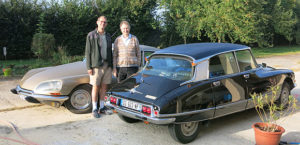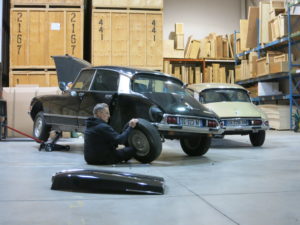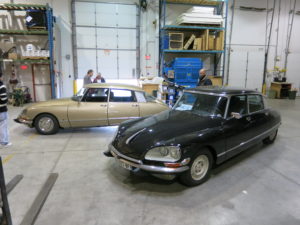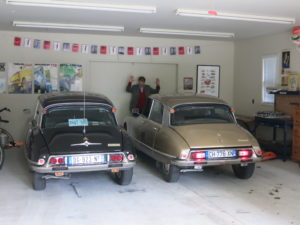French-German DS Chronicle 1990-2000 and Canada 2012 Onwards
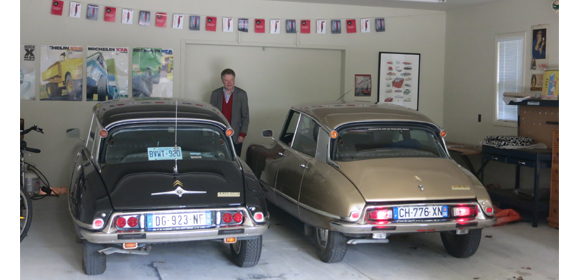
by Pierre Cambillard
Before we start I wish to extend my great appreciation to George Dyke, who relentlessly has led the CITROËNVIE Club to become a world leading Citroën club by his dynamism, activities and membership support. And thanks to another charismatic President of a DS Club, Martin Kraut, who started the DS Club Deutschand in Germany in the mid-80’s where my passion for DS was ignited in 1989.
My story tells what I experienced in the 90’s with several DS in Germany as well as the my latest Canadian period starting in 2012.
Part 1 : the German 90’s DS Era.
I met Martin in the late 80’s when I lived in Marburg, 100km North of Frankfurt (Germany), having acquired a farm house with 3 barns dating from 1664 to restore. (All with oak beams with rock hard clay/straw material in between). Martin also shared his passion for restoring a heritage building, and on top of that had a passion and strong technical knowledge of all types of Citroën DS, including Chapron. (He still has the Chapron register, listing which car/serial number was made when!). He had started, with friends from various locations in West Germany, a club which was meant to organize gatherings and publish a glossy magazine which has become a collector’s item.
The idea was to provide members with useful information on how to maintain the cars and include what was happening with the emerging Citroën parts dealers (many who still exist and now export to Canada!). Most members’ cars were imported used from France because the German ones barely survived the salt and the lack of professional dealer service. In 1990, only one Citroën garage remained where I lived with the capability to do basic servicing of a DS.
My first DS was a 1966 Pallas gris palladium with black leather and Citromatic. It had been customized with a 70’s front end. I got it from Elsace for 6000 euros. The DS Club Germany was very environmental minded and had a catalytic exhaust built for the DS, which passed all severe tests of the German regulator. I remember that a special protection had to be installed under the chassis, because the catalytic converter gets very hot. The incentive to install all this was an important tax break on the road tax (at that time no cheaper historic car plates). Later on I had a foldable fabric sunroof installed (a very good imitation of the one made originally in the 70’s).
Soon I wanted a car to drive every day to work, all year round, which meant 30 km per day. I hunted down a 1967 ID 19 break (manual shift) from a miller in central France. I had seen an ad in la Vie de l ‘Auto (that magazine still exists) and after a couple of calls went with Martin on a 800 km drive to see it. The car was good, and after the deal was concluded with some wine induced assistance, we hit the road non-stop for the 800 km trip back. I recall that the maximum speed for the ID was about 110 km/h and the front bench was nothing compared to seats of a DS.
However the ID 19 became the perfect daily driver. It was easy to maintain and with proper rust prevention it made it through several summer and winters. The only repeated breakdown was the starter, which needed an overhaul a few times so I eventually carried a spare in anticipation of being stuck.
A funny story is that by then I was part of the company’s top management, with a reserved parking in front of my office. Senior colleagues parked their S class Mercedes, younger ones their E class, with the exception of the Head of Production, who drove a Xantia. My ID helped me a lot (I was in Sales) to get a good rapport going with the production department!
Of course once in a while I needed spares like a turn signal or such, which I would source in La Vie de l’Auto. This is how I got to know Didier Blin, who is now my oldest French DS friend. At that time he was organizing, as President of the Citroën Club du Perche in Nogent le Rotrou, an annual Citroën meeting. It was widely popular. DS cars in France were not really collectible, except for the Chapron models, including the factory convertible. A top factory convertible would sell in late 90’s for the equivalent of 55.000 euros, which was 5 times the price of a DS sedan.
While finishing my barn restoration mid 90’s, I had the urge to embark into a convertible project. At that time there were very few good restoration shops besides a famous Swiss facility and one German shop in the north. A full restoration had a price tag of 75.000 euros, and the waiting list was over 2 years, with most customers from Holland (where there is still a strong DS scene). My idea was to get a good restoration done on the core of the car and then finish the project myself, working with an expert for the chassis/engine, the interior, electrics and exterior paint. All this in 4 different locations in Germany. I found a complete but tired convertible in the US in New Jersey, a 1966 manual shift, which I got shipped to Antwerp and then drove to Marburg with the US plate, (which did not draw attention in Germany since we had American Forces there driving cars with US plates).
I wanted to change the chassis to a 1967 model with green hydraulic, so first I got from France an ID 19 Familiale. It was really too good to part out, so we agreed not to touch it and sell it as it was. The search continued till I found the right DS 21 Wagon (also with a good engine). The trouble was that when the transplantation of the convertible back end took place, no one had the original Chapron tools to measure to the mm the proper positioning. So it was only once the paint was on that the sides showed a slight inside curve, due to the undercarriage being 1 or 2 cm too short. This was impossible to correct later on and contributed to my decision to eventually sell the car.
The other phases of the restoration went very well. In particular, an excellent interior job with beige Mercedes leather. The paint was rouge cornaline and the top black. I drove the car several times to France. My kids probably will remember it when I had them on vacation in Brittany, open top touring through the Mont Saint Michel region. The trouble was with rain. I never found out why, despite having installed proper drainage for the top, some water would leak onto the carpet in front of the back bench.
Life started to change late 90’s when Debbie, a Canadian Deesse, entered my life and we moved to Siena /Italy where I was promoted to manage the international sales of the company. An American corporation had acquired the German company where I was previously based, and had already made an acquisition in Italy. I was happy to move but what to do with 3 DS ? I had sold my farm, and dry garages were difficult to find in Italy. I was totally aware that a DS is a car you have to drive. To store it a long time was no good, and I became too busy with my professional life to cope with all. So I decided to keep only the convertible. It was fun to drive it on the windy roads of Tuscany, but again, I had no garage and the car was parked with a cover on the factory compound. And then one day, I remember it was in the village of Montepulciano, Debbie spotted from distance a parked that had a hard top which was opening. We had a closer look, it was a Mercedes SLK. Well that was more sportive for Tuscan roads, and I managed to get one with all possible extras as a dealer show model in Germany, for less the price my slimmed down convertible was worth: 40.000 Euros. The convertible was sold through the DS club in Germany to a Belgian person I never met. He bought the car based on pictures and an appraisal report from Martin (known in Germany as a Citroën expert, like George). He sent a trailer and one Sunday my car went off the factory compound to be never seen again. Believe it or not, the (Italian) guard at the factory entrance was crying!
What remained were just 2 boxes of left over parts for a 1967 model, including a few goodies for a convertible.. This ends part 1 of the Chronicle.
Part 2 : Canadian DS Revival
In 2010 I took steps to retire and spend part of my time in Paris, Ontario Canada where my Debbie has a long time dear friend, David. I wanted a downtown house with a big garage, which we managed to find. The garage was a former workshop, newly built with insulation and underfloor heating. Perfect for historic cars. I never suspected anything like DS experts in that region and had in mind to look at a collectible Mustang. However, David knew a person in Toronto driving a DS and also one driving a 2CV, so he provided me those connections. I quickly found out the ‘honey pot’; Bernard who was Citroën trained mechanic who worked on classic Citroëns in nearby Toronto, and George and other members of the Citroën Club. I went to their 2012 Christmas party, having already in mind to buy a DS.
I told Didier in France about it and he said it was time for him to give up his 1973 DS 23 IE Pallas with Citromatic that he had owned for many years and regularly drove to meetings. I knew his car was great, but not 100% genuine. So I kept searching for a 1967 DS 21 Pallas gris palladium having leather and Citromatic, in mint condition. Being in Canada, with only a couple of DS in the entire country, that was going to be virtually impossible to find. And nowadays finding one overseas with adverts on Le Bon Coin and people rushing with cash the very next day an ad comes out, chances weren’t going to be much better there. Add to that some dealers are not necessarily commendable and tend to charge astronomical prices. Then, in May 2013, I flew into Nice and with jet lag keeping me awake I surfed the ads in the German DS Club, to discover a beautiful genuine 1971 DS 21 IE pallas with Citromatic, located in the south of France. After a few calls next day I had figured out the car was in Castellane, at the Citromusee founded by another charismatic person, Henri Fradet. To my disappointment Henri said on the phone that the car was meanwhile sold, but I wanted to see the museum and made the the 2 hour drive up from Nice. I saw the car which was sold to an Austrian, and many other fantastic cars in the museum. Henri only buys genuine cars, and once he gets even a better one of the same type he considers to sell one. When departing he said to me “You never know, some people do not follow through on their purchases” and then, 10 days later, 2 days before my return to Canada, came a short email telling me that if I still wanted the car I could have it. The rest is history and is already well narrated by George on the CITROENVIE blog. [See “Driving a “True” DS in France”]
Postscript:
I believe I did the right thing to import the 2 DS in a container, considering the Citromatic is very unusual for RoRO (roll-on, roll-off) car jockeys in Halifax. Besides, I had my own (bad) experience with CBSA handling my personal belongings in Montreal, so there was only one way in my mind for safe transport to Toronto (with no damage to the cars). The cars went from Antwerp to Halifax, then in the same container on a train to Toronto, (Brampton). I had a fantastic forwarding agent in Antwerp, Ronny Verschaeren. The Bill of Lading indicated that wooden blocks used for blocking the wheels had been properly fumigated and that the compulsory seals were applied. And cleaning certificates from a garage in France were also copied in the documentation.
All went smooth, with a very supportive and qualified government officers at Service Ontario in Brampton where I was able to purchase 10 day temporary permits to drive the vehicles to Paris Ontario. I called my insurance company an added them to my automobile policy. (Though I have subsequently insured them with a classic car insurance broker that is far less costly). I did the Canada customs clearance at their West Street office in Toronto and used Brytor International Moving Inc. in Mississauga for getting the container to their Customs Bonded warehouse, where the cars were driven out by George (who had driven them into the container in Antwerp) and then immediately appraised by Dean Renwick of Antique & Classic Auto Appraisal Service. George drove the DS 23 to Paris while Lloyd McBride came along for the day to drive the DS 21 and I drove behind in my daily driver Audi as a’ support’ vehicle if need be. No need as the only problem encountered was a flat rear tire on the black DS 23 when the wood support was removed in the container. A nail had been driven through the tire when securing the wood in Antwerp. It held air until the nail was pulled in Toronto. At that point we got to demonstrate how to change a tire on a DS to the amusement of the Brytor warehouse personnel.
Once safe at home in Paris all I needed to do is go to Service Ontario for license plates, pay the fee and show them a certificate issued from my local repair shop which did the road safety test. The Service Ontario office also certified the VIN was not the usual 17 digits that their data system normally processes.
And now I can enjoy my 2 wonderful DS in Canada!
